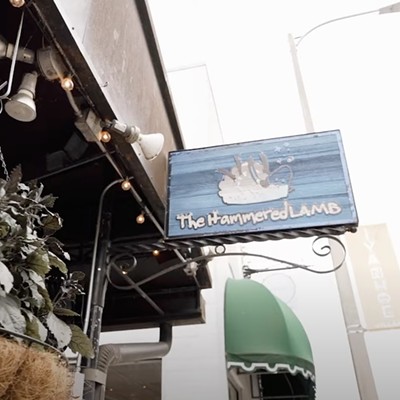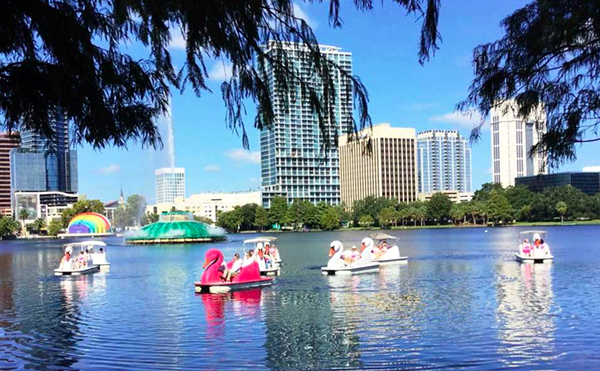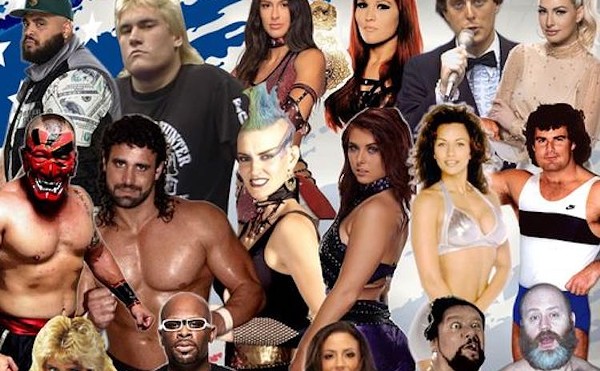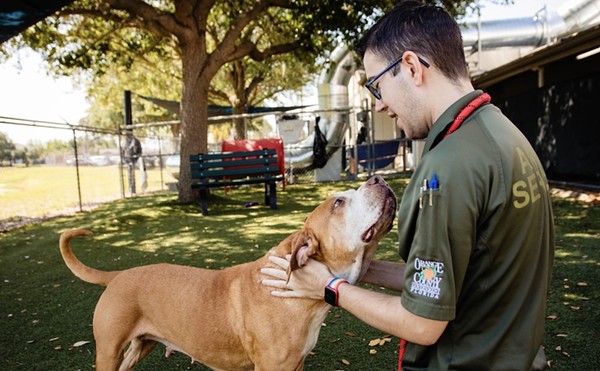After a week of scorching May temperatures and almost motionless air, a cooling cloud cover and gusty easterly breeze grace the New Smyrna side of Ponce Inlet. It's not yet noon on a Monday, but as if from out of nowhere, a convoy of dusty Jeeps, SUVs, pickup trucks and compact cars with surfboards tied to their roofs appears on the hazy southern horizon. The drivers are having a difficult time adhering to the posted 10-mile-an-hour speed limit for beach traffic in their push toward the long rock jetty.
"Carpe diem!" yells a teen-ager in blue floral board shorts and flip-flops as he and his two passengers leap into the sand. "That means, 'Seize the moment,' or is it, 'Seize the day'?"
"It means, 'Seize the surf!'" one of his companions shouts as he yanks a cream-colored long board from the truck bed.
It is a "swell" day for surfing. The air temperature is in the manageable mid-80s, and the water is an inviting 76 degrees. Even more important, the winds are kicking up ever larger sea swells, rising quickly from knee to waist to chest high.
"We live and die by the weather," says veteran surfer Chuck Carter. He runs Nichols Surf Shop along the Flagler Avenue business district two miles down from Ponce Inlet, which is widely regarded as one of the best surfing spots in the eastern U.S. "Everybody checks the surf forecasts on the Internet or by phone, or sticks a thumb in the air. When the winds are right, you can't keep surfers away."
That's true at all times of year, even in summer when the surf is usually "flattest," Carter says. From late fall through early spring, New Smyrna Beach draws professional and amateur surfers from all over the country for contests sponsored by such groups as the Eastern Surfing Association and the Amateur Athletics Union. But once the snowbirds and spring breakers leave, it's mostly Florida surfers who come to enjoy the special assets of the inlet, named for explorer Juan Ponce DeLeon who stumbled upon it in 1513 on his search for the "fountain of youth." To many enthusiasts, DeLeon landed in exactly the right spot.
"For consistency of conditions, you just can't beat Ponce," says surfing instructor John Brooks of Inlet Charley's. "Though Cocoa may be better known, even a lot of those guys admit that we get the best waves more of the time." That, he says, is because Ponce is such a wide inlet; the incoming and outgoing tides are abetted by the jetty to push out lots of sand, creating bigger dunes for better waves.
Of course, every surfer has his or her own personal reason to pick Ponce.
"It's the girls," says Orlando's Ben Heimburger, who is making his final visit to the inlet before joining the Air Force. "There's more cute ones here than in Cocoa. ... And you can't park on the beach in Cocoa."
"Also, the water's clearer here than in Daytona," says a friend who took the day off from high-school classes to join him. "You can see your feet."
"Sometimes you can even see the sharks," Heimburger says with a laugh.
Last year, 22 people were bitten by blacktip and spinner sharks in the coastal waters of Volusia County, almost all of them in the popular surfing spot just north of Ponce Inlet. That's nearly two-thirds of all the 37 shark bites in the state, and almost double the number bitten around Ponce a year earlier. Despite the resulting barrage of bad publicity, few surfers are intimidated.
"We have to share the water with the sharks," Heimburger says. "After all, they live there. We just drop in from time to time."
And more people are dropping in all the time. "The number of shark bites hasn't increased per capita," says Carter's store manager, Ren. "There's just a lot more capita every year."
Marc Latorre, a 26-year-old former surfing instructor who works at the Kennedy Space Center, says the problem is that "a lot of people, particularly those coming over from places like Orlando and Tampa, don't know what to look for. If you see bait balls -- schools of bait fish -- jumping, then get out of the water. The fish don't just leap into the air for the fun of it. And, if you see flocks of seagulls or pelicans diving, come on in to shore."
Latorre remains high on surfing at the Inlet, even after having to give first aid to a bitten fellow surfer there last month, one of the first three bites recorded in Volusia County in 2002. "He had a pretty nasty wound to his foot," Latorre says. "But most bites are just nips. Think about it from the shark's perspective. You like to dine on little white fish, and you see the white bottoms of some guy's feet paddling around. You get confused until you take a nibble; then you spit it out and swim away. Wrong menu choice."
"The sharks around here don't come back for seconds," adds Carter. "It's not like we have great whites who take off whole body parts."
Some of the sharks at Ponce are more than pint sized, however. Bill Scott, who has been surfing since the Beach Boys first sang of "surfing safaris" in the 1960s, describes the day last month when he found himself riding alongside a 14-foot lemon shark. "I kept my feet on my board. I know when to pull the produce out of the feeding trough."
Scott, who has homes in Edgewater and the Florida Keys and who travels frequently to Costa Rica for surfing expeditions, is an example of how diverse in age today's surfers are. Old enough to be a grandfather, he often takes midday breaks from his business as a hurricane-shutter installer to catch a wave or two with his two adult sons, one of whom he is keeping an eye on in the surf. It was Scott's sons who persuaded him to "get back into" surfing 10 years ago when they surprised him with the gift of a new long board. "It was the greatest present," he says, drying himself off. "And this is my favorite place in Florida to use my board. In fact, I drove up here after a late job last night just so I could squeeze in an hour or two before my next job this afternoon."
The return of the classic long board (9-feet or more in length) is a major reason many retired surf veterans are returning to the waves. "For awhile, the short-board revolution ruled," says Latorre. "They're faster and easier to maneuver, so you can do more tricks, more 'hot dogging.' But the classic long boards have become popular again; they give more flotation and are easy to paddle, so they're less difficult for older people and beginners to control."
Latorre hopes to have his 2-year-old daughter on a long board soon. "She's doing great with swimming lessons, so a surfboard could be in her future."
More women also have turned on to surfing. As a little girl, Bobbie Werner moved with her family from New Jersey to New Smyrna in 1982, but it wasn't until six years ago that she picked up a long board. "I had done a lot of boogie-boarding here, but I wasn't so sure about surfing. Then I started seeing more women go out. I also started seeing [female surfers] on ESPN and in magazines; suddenly there was lots of exposure. So, with the help of some friends, I learned the ropes; and I love it." She says she's also "thrilled to see professional women surfers actually making money, like the guys do."
Like her male counterparts, Werner admits to only the "slightest reluctance" to surf Ponce Inlet in the warmer months when more sharks appear in local coastal waters because of the migratory patterns of the fish they eat. "I've got a lot bigger chance of cutting my foot by stepping on a crab or being stung by a jellyfish," she says, "or of being struck by lightning, particularly here in Central Florida."
"Or, of getting in a wreck on I-95," adds Brooks. "The reality is that in this county we've never had a shark kill a surfer, but we've had plenty of drivers killed."
Carter offers another twist on the dangers at the beach. "I'm constantly having to remind out-of-towners to use a good sunscreen," he says. "They worry about sharks, but they'll go out all day and fry themselves; then they'll wind up with melanoma cancer when they're 40." He also suggests that guys wear rash guards, specially designed surf shirts to protect them from the sun's rays.
Brooks says he's honest with his novice surfing students, telling them, "There is some inherent risk in surfing, as there is in any sport. But, as long as you learn the basics and use a little common sense, there's no reason to fear anything -- except the drive back to Orlando."
For the uninitiated, several surf shops on Flagler Avenue offer surfing lessons for beginners and rent boards by the day. From the ocean block of Flagler, the easiest way to reach Ponce Inlet is to pay $5, drive onto the beach and turn left (north); go approximately two miles to the jetty. Or, you can reach the inlet through Smyrna Pines Park. Admission is $3.50, and you'll have to hike a half-mile boardwalk through the dunes to reach the beach, but you'll also have access to changing areas and restrooms. There is usually at least one concessions truck parked on the beach near the surfing area.
















